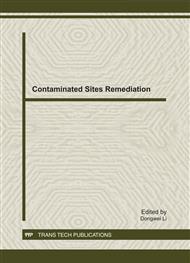[1]
S. M. Lin, Research on lead and other heavy metals emission and prevention of cement kiln. South China University of Techndogy, Ph D thesis, (2009).
Google Scholar
[2]
D. H. Yan, L. Li, Q. F. Huang, et, al., Distribution of heavy metals during co-processing hazardous wastes in new dry cement kilns. China Environmental Science. 29(9) (2009) 977-984.
Google Scholar
[3]
H. Z. Hao, T. B. Chen, M. G. Jin, et, al., Recent advance in solidification /stabilization technology for the remediation of heavy metals contaminated soil. Chinese Journal of Applied Ecology, 22( 3) (2011) 816-824.
Google Scholar
[4]
X. P. Wang, X. Y. Zhao, W. X. Jin, et, al., Study on detoxication of Chromium contaminated soil with organic fertilizer. Environmental Science, 7(3) (1986) 18-21.
Google Scholar
[5]
C. Li, Study on kinetics of Chromium(Ⅵ) reduction by organic acids and their impact factors. Nanjing Agriculutral Univesrity. Master thesis, (2006).
Google Scholar
[6]
B. Liang, Study on Chromium(Ⅵ) reduction by organic substances and its impact factors. Nanjing Agriculutral Univesrity. Master thesis, (2007).
Google Scholar
[7]
Y. H. Xu, D. Y Zhao, Reductive immobilization of chromate in water and soil using stabilized iron nanoparticles. Water Research. 41(2007) 2101 – 2108.
DOI: 10.1016/j.watres.2007.02.037
Google Scholar
[8]
R. Liu, Q. X. Zhou, Q. Y. Ma, Applications of nanomaterials in remediation of contaminated water and soil: A review. Chinese Journal of Ecology. 29(9) (2010) 1852-1859.
Google Scholar
[9]
H. G. Sun, Study on the Preparation of Silver Nanoparticles by Chemical Reduction Using Sodium Hypophosphite in Solution. Sichuan University, Master thesis. (2005).
Google Scholar
[10]
Y. Z. Zhu, Absorption and reduction of Chromium in soil. Emvironmental Chemistry. 1(5) (1982) 359-364.
Google Scholar
[11]
J. Kumpiene, A. Lagerkvist, C. Maurice, Stabilization of As, Cr, Cu, Pb and Zn in soil using amendments–A review. Waste Management. 28 (2008) 215–225.
DOI: 10.1016/j.wasman.2006.12.012
Google Scholar
[12]
J. G. Jiang,W. Wang, G. D. Li, Experimental study on chemical stabilization in treating fly ash with heavy metal chelating agent. Shanghai Environmental Science. 20(3) (2001) 134-136.
Google Scholar
[13]
H. J. Zhang, Y. Yu, Y. W. Ni, et, al., Stabilization of Heavy Metals in Municipal Solid Waste Incineration Fly Ash with the Thiol Collectors. Environmental Science. 28(8) (2007) 1899-(1904).
Google Scholar
[14]
Z. Tian, H. X. Li, L. J. Sun, Study on treatment process ofwastewater containing Cr3+, Cu2+, Ni2+ by using heavy metal chelating agent DTCR. Chemical Engineering (in Chinese). 36(3) (2008) 68-71.
Google Scholar
[15]
Z. H. Yang, B. Wang, S. H. Huang, et, al., Chromium fractions in soil contaminated by chromium-containing slag. The chinese journal of nonferrous metals, 18(suplement 1): (2008) 372-376.
Google Scholar
[16]
Y. Ding, S. Q. Zhou, G. Z. Zhao, Determenation of Chromium in soil and notices. Modern Angriculture. 2(1999) 12-13.
Google Scholar
[17]
W. H. Su, Improvement of Diphenylcarbohydrazide Spectrophotometric Method used to Determine Hexavalent Chromium in theWater. Environmental Science Survey. 28(5) (2009) 77-78.
Google Scholar


